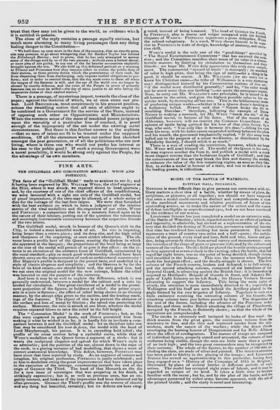MODEL OF TRY BATTLE OF WATERLOO. EGYPTIAN HALL, PICCADILLY.
NOTHING is more difficult than to give persons not conversant with mi. litary matters a clear idea of a battle, whether by means of plans, de. scriptions, or pictures, or all together ; nor should we have supposed that even a model could convey so distinct and comprehensive a view of the combined movements and relative positions of forces of two contending armies, as to make the nature of the action and the causes of defeat intelligible to unprofessional eyes, hied we not been convinced by the evidence of our senses. Lieutenant SUBORN has just completed a model on an extensive scale, of time Battle of Waterloo ; which, regarded merely as an effort of patience and ingenuity, is admirable, but viewed as a representation of the vie. tory that decided the destiny of NAPOLEON, possesses a national interest that time has rendered less exciting but more permanent. The model represents a tract of country two miles and a half square ; the undula. Lions of the ground, every road and lane, field and tree, house and gat. den, being accurately shown from actual survey and measurement : even the varieties of the crops of grain nr grass are indicated by the colours and texture of the surface. On this field are placed the hostile armies,urranged as they appeared at seven o'clock in the evening, when the battle, that had raged for eight hours, was 011 the point of being decided, though victory still trembled in the balance. This was the moment when Napoleon made his lastgreat effort ; and the deadly struggle is shown. The first column of the French reserve, broken and defeated, is in full retreat; arid the second attacking column, composed of six battalions of the Imperial Guard, is advancing against the British line : it is immediately opposed to Maitland's Brigade of Guards in front, and Adams's Bri. gade of Light Infantry on its left flank ; Sir Hussey Vivian's Hussars advancing to support the Infantry. This being the main point of attack, the attention is more immediately directed to it ; especially as Wellington and his Staff are seen behind the Artillery placed in the angle formed by the two brigades of Infantry. Napoleon is seen on a little eminence receiving the retreating column of his Guards; the attacking column have just before passed by him. The disposition of the rest of the forces, including the advance of the Prussians under Blucher, and those under Bolos,/ attacking the village of Planchenoit, occupied by the French, is distinctly shown ; so that the whole of the operations are comprehended. The smoke is extremely well imitated by locks of fine wool: the thick masses from the great guns, the continuous volume from the musketry in line, and the thin and scattered smoke from the skir- mishers, mark the nature of the warfare ; while the dense clouds enveloping the burning houses of llougoumont and La Belle Anjou' show the effect of conflagration. The masses of troops are composed of individual figures, properly armed and accoutred, the colours of their uniforms being visible, though the men are little more then a quarter of an inch high ; and the two great commanders may be recognized by their costume. The whole of the figures, to the number of 190 OK in' eluding the slain, are made of silver and painted. The strictest attennou has been paid to fidelity in the placing of the troops ; arid Lieutenant SIBORN has served an apprenticeship in this particular, having been long engaged on a " History of the Campaign of 1815 in Belgium," illustrated by plans of several battles at different periods of each action. The model has occupied eight years of labour, and it may be regarded us unique of its kind. It takes a little time to become familiar with the scene ; but by, and by the plan of the battle, and the advantages possessed by either army, become apparent, with the aid of the printed Guide ; and the study is novel and interesting.


























 Previous page
Previous page